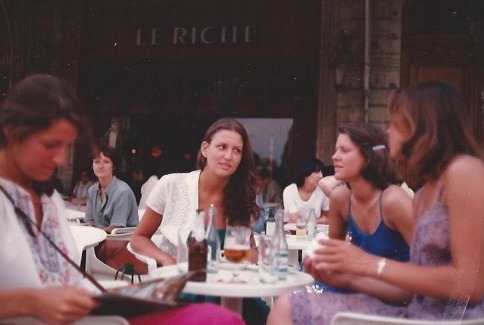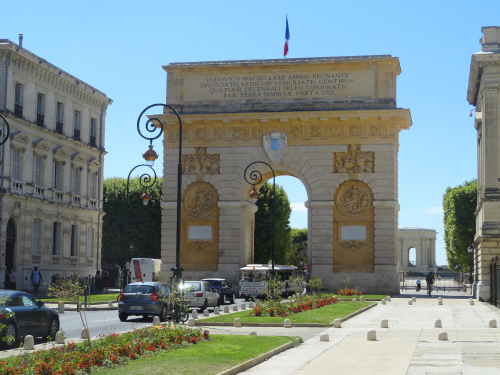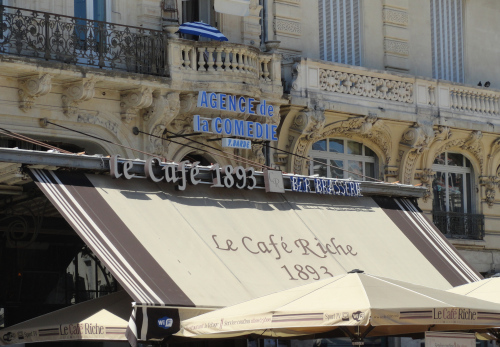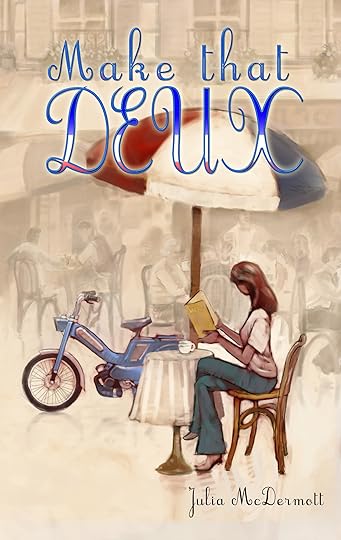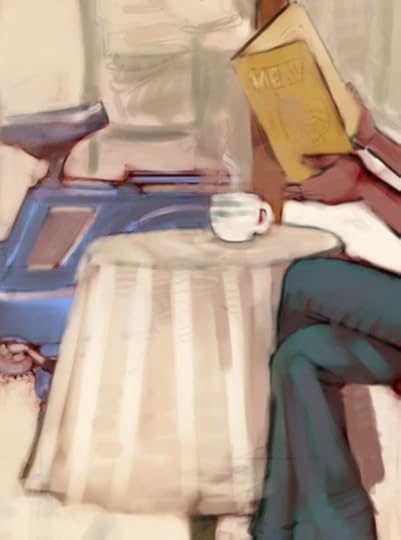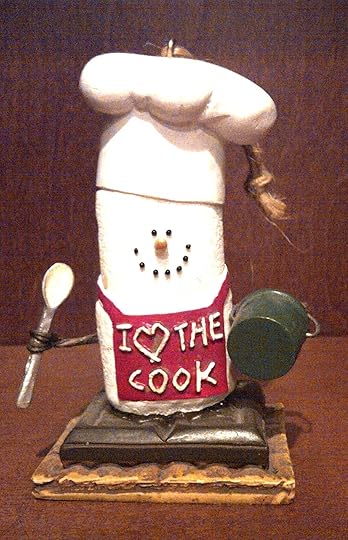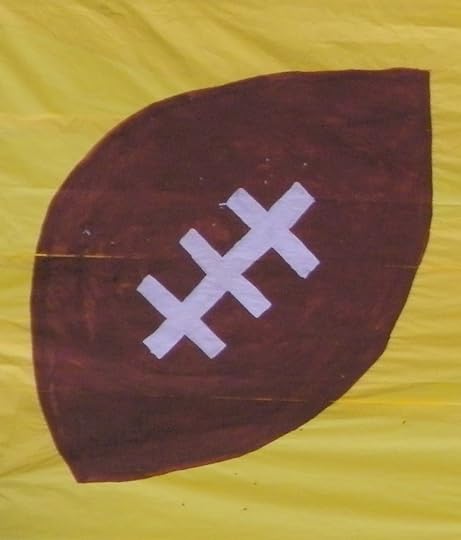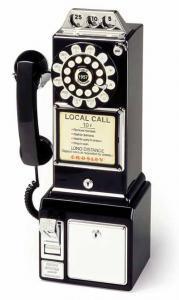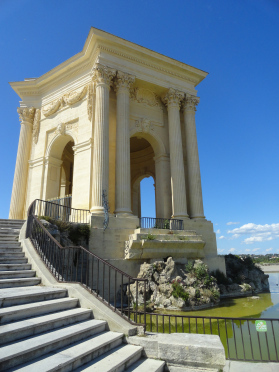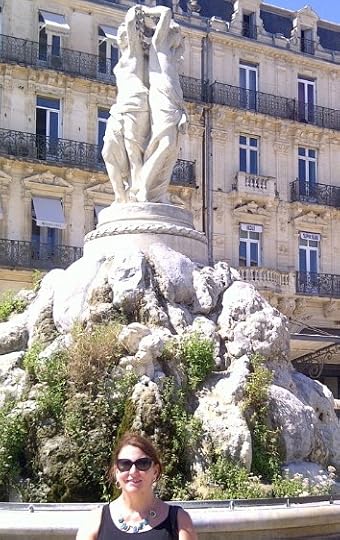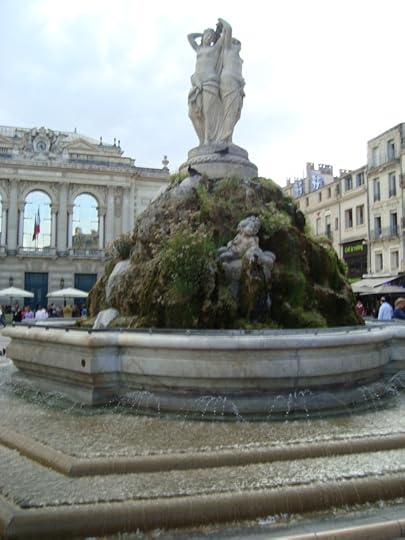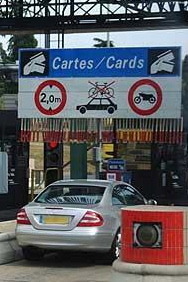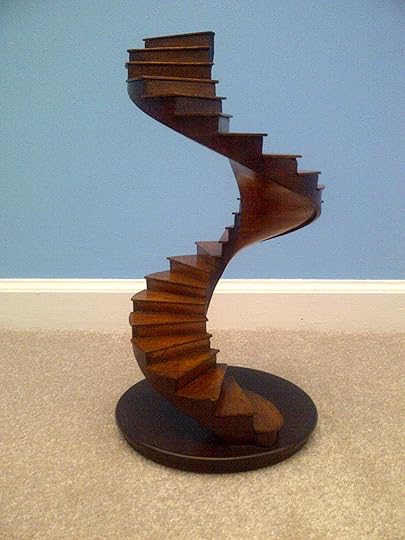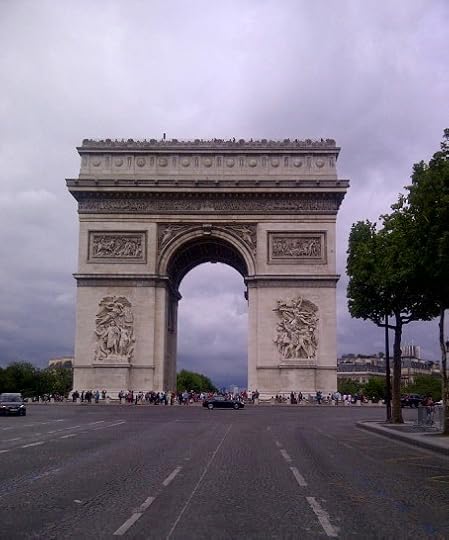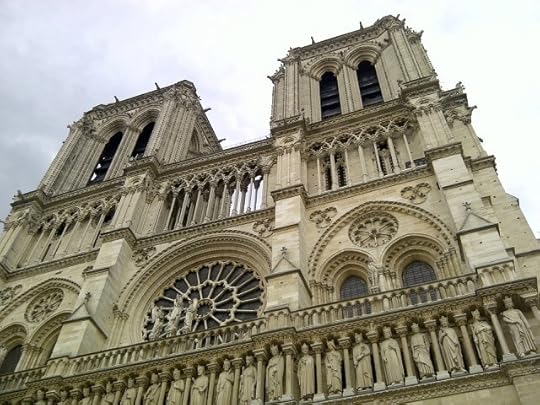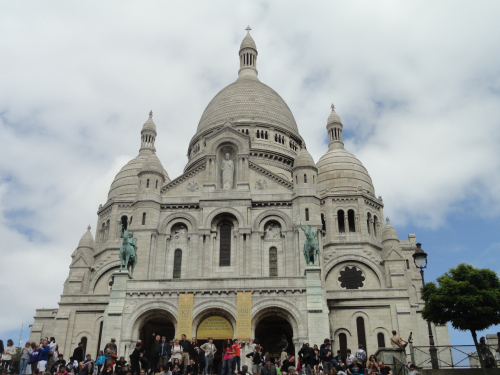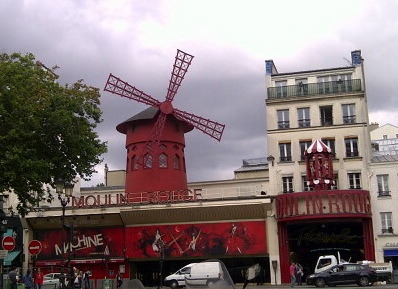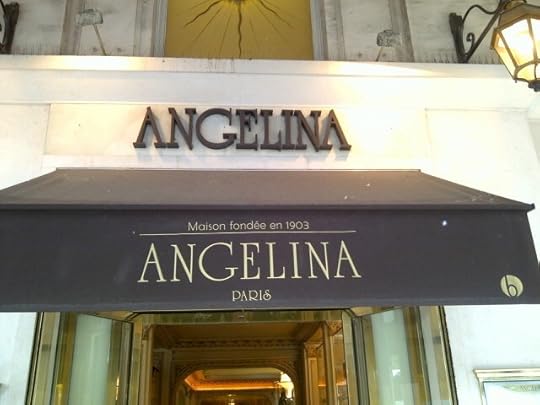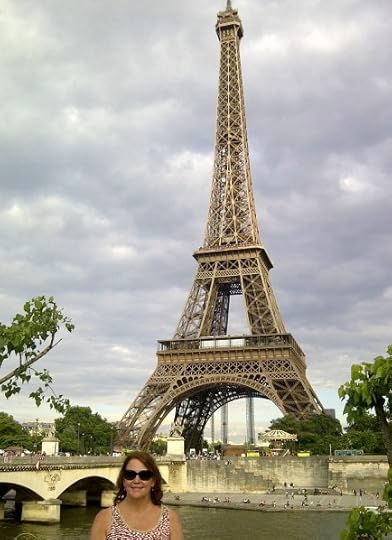Julia McDermott's Blog, page 27
October 16, 2012
La séduction et l’élégance: summing it up
Just after my new novel MAKE THAT DEUX was released* last week, a friend sent me this recent feature in the (UK) Telegraph Travel titled
“36 Hours in…Montpellier” France. Its first line:
“Montpellier, the most seductive city in the French south at any time, is elegant and cultured, with an autumn sun warm enough to sit out on its squares.”
And, long ago, I did that with friends…
Then
Just over three months ago, I returned to Montpellier for the first time in many years. I spent 36 hours in the city and at the closest beach (in nearby Palavas-les-flots) with mon mari during our vacation. We walked by Le Riche - the café in the above photo in Place de la Comédie — but didn’t stop, because we found it crowded with summer touristes. We chose instead a quieter spot to have a drink, nearer to the city’s own Arc de Triomphe and close to Place de la Canourgue. Later, we had dinner at a tiny, elegant restaurant in the area. For so many reasons, it was the perfect place to relax and celebrate a milestone anniversary.
MAKE THAT DEUX is set in Montpellier and Palavas, and the girls in MAKE THAT DEUX explore the Montpellier of an earlier time.
Has very much changed over the years? I think this sums it up:
Oui, et non.
In their époque, unlike today, studying abroad for a year or semester was not something that many people did. A university degree was (relatively) expensive, but not ridiculous. Moving back in with your parents after college was uncommon. College kids age 18 and over could drink legally in the U.S., not just in Europe. Cigarette smoking wasn’t restricted, nor was it even unacceptable. People — including lovers — wrote letters to each other on paper, and sent them through the mail.
What hasn’t changed? Back then, like today, terrorism was a major issue, and events gripped the world stage. A democrat was in the White House. College graduates had a very hard time finding a job. But while IN college, in addition to studying, students went to parties, met new people and went out on dates. Sometimes they even fell in love.
And — like today — they didn’t tell their parents anything everything about what they were doing, especially when it involved la séduction…
Now
* See my HOME page for how to order MAKE THAT DEUX! Merci!


October 10, 2012
Make that…my book cover! — et son histoire
As promised…
Because the French are very good at mathématiques, here’s the story of the creation of my book cover, in an equation (une équation):
La serendipité + L’artiste * [l'inspiration + le talent + la technologie]
= MY BOOK COVER (La couverture de mon livre!):
Les détails:
Serendipity: Last spring — at long last — I finished the final edit of MAKE THAT DEUX, and began planning its publication. A top item on my to-d0 list was to find a cover artist. Then, just before Easter, my daughter and I visited beautiful Sarasota, Florida for several days during her spring break. “Kim” lives in Sarasota and she invited us to spend one afternoon with her and her husband at their beach cabana.
I told “Kim” about my plans for publication, and she mentioned a friend and cabana-neighbor, writer Peter McKenzie, author of THE PARAGON GANG. “Kim” suggested I look up Peter’s book on Amazon and give him a call. I found the book, downloaded it on my iPad, and called Peter. When I complimented him on his book cover, he recommended the artist, Michael Faron of Sarasota. Back in Atlanta, I read through Michael’s website www.msfaron.com and sent him an email…
Et voilà! I had found my cover artist.
The Artist: First, Michael read MAKE THAT DEUX. Then we began discussing ideas and sketches that he sent me. We narrowed them down to one… and, aided by inspiration, talent and technology, Michael did the rest!*
As an added bonus, here’s the book description for MAKE THAT DEUX that you will soon see on Amazon:
Three American college girls living in an apartment on the Mediterranean. Two boyfriends back home. “The One” (and only), if it’s “meant to be” — whatever that means!
Jenny Miles has three goals: to speak French like a native, to travel all over Europe, and to have a blast. Meanwhile, two men compete for her attention and amour, ici et là. C’est compliqué!
Take 10 months. Add 2 (surprise) transatlantic flights, 2 Greek isles, 1 moped (une mobylette) and beaucoup de lettres! Subtract 1 phone, 1 promise to be faithful, and 1 bikini top. La solution?
Make that…a year that Jenny will never forget.
In the cover art that Michael created (and in the book description above), somehow I’m reminded that the more things change, the more they stay the same…
* Including the back cover, which I may reveal in the future…


October 5, 2012
Le menu, and making a choice
“Vous avez choisi?” (Have you decided?)
– a French waiter
Choices can be difficult, and many of them haven’t changed (but they may have evolved over time):
Café américain or café au lait? Prix fixe or a la carte? Wine or cocktail? Skirt or pants? Flats or heels? One-piece or bikini? iPhone or BlackBerry? Paperback or e-book?
The list goes on, and making the right selection can sometimes be a daunting task — or at least, pretty stressful. Especially when it’s not possible to choose both alternatives, like buying two pair of the same shoes (or pants) in different colors. Something I’ve been known to do…
But back to restaurants and cafés. When one must make a choice, sometimes it’s best to study the menu (en français, “la carte”), and sometimes it’s better just to glance at it and look for something appealing. The same could be true for art, and for fiction…and some people judge a book by its cover.
Which brings me to the image below: a small bit of of the cover of my novel, MAKE THAT DEUX. The full cover will be revealed next week…
What’s on the menu?
Beaucoup de choix:
Classes. Beaches. Museums. Wine, and pastis. Baguettes, croissants and mille feuilles. Windsurfers. The Alps. Love.
Bon appétit!


October 3, 2012
What would Julia do? Faire la cuisine française
Anyone can cook, with butter.
- Anonymous
My husband and I heard that offhand comment a few years ago at a fête — and a new (ironic) family motto was born.
Because, not anyone (such as, well, me) can cook, even with butter — an ingredient that my husband doesn’t fear.* En fait, because he enjoys faire la cuisine (and since I don’t know how), he does the cooking in our home, toujours — every day — an arrangement that works for us, and one that’s never changed.
(If he doesn’t feel like cooking, we order a pizza, eat leftovers, or go out.)
As you might imagine, some of our his favorite recipes are found in cookbooks written by Julia Child.
If I were Julia Child
So, whenever he tries a new and complicated recipe (which is often) — if it calls for butter (which is quite often) — someone in our family might remark to him that, well, “anyone” can cook with it.
Then, he laughs…and concocts something délicieux.
I blame my inability to cook on my family growing up: my father did the cooking, so I thought that was normal. Evidemment, it was one of the qualities I looked for in a husband. That, and a sense of humor, patience, and optimism, among others.
But from what I’ve observed, cooking almost requires those three — at a minimum.
In my soon-to-be-available novel, the main character, Jenny, is a girl in college, and in one of my favorite scenes, her date cooks dinner for the two of them at his apartment. I’m not saying whether butter is involved, but wine is — c’est certain. But c’est la France, so c’est necessaire. The evening is a memorable one, but not because of the food. I won’t describe it further here, except in these words: guitar, bathroom, and (full) disclosure.
Jenny has her own list of qualities that the ideal man should possess, and I’m not sure they match my own. Let’s just say, she’s open to persuasion.
I don’t know what Julia would do. But – what will Jenny do? Il faut acheter le roman! (You have to buy the book!)


October 1, 2012
Le football américain, and good calls
“Je sais que tu adores ce sport…”
— mon prof de français
Football. Fundamentally, I don’t think it’s changed all that much. But many of the rules have changed over time, adapting to better technology, increased risks and just smarter ways to play the game. Two other ingredients of what makes up the NFL have also changed, in my girl-opinion: uniforms, and the players’ personal styles. I’m not sure they’re better, but let’s just say I’ve noticed.
But what makes up a good call (and a bad one) by the referees — les arbitres — hasn’t changed, no matter how much experience they lack have.
The Falcons are my team, and they’re undefeated right now. They’ve got a great quarterback, a talented offense and a strong defense. There are other good teams in the league, including the Green Bay Packers. I’m not really a Packers fan, and I was asleep last Monday night when the controversial touchdown call was made that resulted in a win for the opposing team. But like many other people, I watched the replay and I couldn’t believe the call. So on Thursday, I was ecstatic when the real experienced refs were back.
Yesterday, in an incredible match de foot between Atlanta and the Carolina Panthers, the Falcons won by two points after a final minute of terrific plays. Another close game followed: Green Bay against New Orleans. That game wasn’t without controversial calls, but despite that, the Packers won by a point.
Phew.
I just don’t think I could have handled them not winning again. I should probably like the Saints, I guess, with their French heritage and fleur de lis, but I just don’t — with their issues.
But hey, that could change.
I’ve changed about football. Mistakenly, I used to think (and I’m embarrassed to admit) that it was just a bunch of guys knocking each other down. But because:
1. a son of mine played it in high school
2. being a reader, I read How Football Explains America by Sal Paolantonio, The Blind Side by Michael Lewis and saw the movie (and because of Michael Oher, I love the Ravens)
3. and, we got a high-definition big-screen TV
my football conversion was born. I learned the rules and started to understand the game: Runners dodge, carry, break tackles and get yards. Passes are thrown and caught, sometimes by the opposing team. Kickers kick — and they have to do it well. Players protect the quarterback, who fakes, hands off or passes to a receiver. I’ve learned (most of) the penalty calls, though I still don’t always get what “holding” is, why “illegal motion” is bad and why we can’t have “forward laterals,” at least, occasionally.
Just kidding. I don’t really like any lateral passes.
Anything can happen in football, as the last sixty seconds of the Falcons-Panthers game demonstrated yesterday. In my view, each play is an un-choreographed dance (though I’m sure the coaches and players would say each one is quite well choreographed). But the truth is, it’s unpredictable.
Unfortunately, there’s no football in my novel (coming soon), but there is a very important hockey game. The French don’t have le foot, and I think they’re missing out.
Since I think they just might adore it. That would be a good call, n’est-ce pas?


September 19, 2012
Call me, maybe, but don’t break my heart: Sortir avec quelqu’un
From what I’ve seen, dating has changed since mon époque.* But I wonder why les jeunes filles gens of today sometimes make going out with someone more difficult than it used to be.
It’s been years decades since I’ve sorti avec mon copain – gone out with, or dated, my boyfriend (or any other guy – but not au même temps, of course). And though my husband and I have gone out on many a “date night” during our marriage, well, once you’re married, you’re not dating anymore.
But way back when, we were dating. Normalement, he would call me, ask me out, I would say “Yes,” and we would set up a rendez-vous (date). He would call me from a “land line” or even a pay-phone similar to the one in the photo, and I would answer the phone. If he called and I didn’t answer, it meant I wasn’t there, and he would call again. When the time for our date came, I would be almost ready, and we would go to a movie or out to dinner.
I’m not one to changer d’avis (change my mind) very often, so it worked.
But back then, when a guy called and asked you out, if you said “Yes,” you didn’t cancel on him at the last minute (or even before that), unless you got sick, someone died, or you had an accident. Yes meant yes, and it didn’t mean maybe. There was no easy way to cancel, anyway, like there is today. So you just went out — and had fun.
Like lots of people, I’ve enjoyed listening to a popular song recently that demonstrates (I think) how different dating is now:
““““““““`
Hey, I just met you,
And this is crazy,
But here’s my number,
So call me, maybe?
““““““““`
Hmm. Is she going to answer the call, I wonder? When I first heard those lines, it reminded me of a song that mon copain at UNC and I liked, featuring these lines:
““““““““““““““““““““““““`
Why do you build me up (build me up) Buttercup, baby
Just to let me down (let me down) and mess me around
And then worst of all (worst of all) you never call, baby
When you say you will (say you will) but I love you still
I need you (I need you) more than anyone, darlin’
You know that I have from the start
So build me up (build me up) Buttercup, don’t break my heart
“““““““““““““““““““““““““““
In my novel — about to be released — characters go on dates, and (because they live in a time before cell phones, or even answering machines) they don’t stand up their dates. They live up to their commitments, even if they’ve only committed to Saturday night. ”Oui” means “Yes.”
And like today, no one wants a broken heart.
* Autrefois, or back in MY day


September 10, 2012
Avignon and Montpellier encore
Some parts of these two French cities haven’t changed for centuries.
This summer, during our five days in le Midi (the south of France), my husband and I spent an afternoon in Avignon. Arriving after lunch, we spotted and entered a parking garage near la gare with only moderate difficulty (having to back out of an unmarked a wrong entrance, and, with embarrassment, forcing the car behind us to do the same). Heureusement, I was driving.
It was a hot day and, during its July festival, the town was crowded with visitors from France and elsewhere. But perhaps because, as a student, though I’d lived just over ninety kilometers away for almost a year, I’d never ventured over to Avignon, I wanted to see le pont d’Avignon and look around — as a tourist.
We climbed les escaliers to this view of the pont, then saw the Palais des Papes on our way to Place de l’Horloge.
I wanted to visit another famous town in the region, Nîmes, but because we’re Americans (and therefore, had planned to do more than time would allow), we had to skip it and head over to Montpellier, happily* arriving there at cocktail hour.
At my request, our agent de voyage had booked us at a mid-priced more-expensive-than-in-the-U.S. (but still perfect for our budget) Best Western hotel, Le Guilhem, which we loved once we found it.** However, with no hotel bar evident, we set out à pied to find some alcohol a nice restaurant.
As luck would have it, we found one right next to our hotel on Rue Jean Jacques Rousseau called Le Petit Jardin. Malheureusement, c’était complet (full — although it didn’t look that way). Undeterred (but unhappy that our agent hadn’t found and booked it, since we were celebrating our wedding anniversary), we got a table at another restaurant, Volodia, on the same rue, and ordered champagne.
The following day, a Friday, we did some exploring. Some parts of Montpellier were just as I recalled, and some parts of it were quite different. We walked through the campus where I had attended classes and had studied at la bibliothèque. We visited nearby Palavas-les-flots and found my old (and only slightly changed) apartment building. We toured Montpellier some more (mais pas en voiture) and learned a little of its history. It was a strange but wonderful feeling to be in a place where I had missed mon ami.
Château d’eau du Peyrou
Aqueduc Saint Clément
In my upcoming novel, the protagonist and her girlfriends get around Montpellier and its environs very well. They often meet at a café in the centrally located Place de la Comédie, or at the statue of Les Trois Grâces in front of the Opéra National de Montpellier.
Les Trois Grâces in Place de la Comédie
All of which are still there — though somewhat changed.
* at heure de pointe (rush hour)! As we inched along in a traffic jam from the autoroute, a siren-blasting emergency vehicle passed us and several other vehicles with difficulty, due to a complete lack of room.
**See the post Le Tour de (Montpellier) France


September 5, 2012
Bonjour! L’etiquette française
The French are a very polite group, à mon avis.
First of all (and this has been true pendant longtemps), everywhere in France, one always greets another — n’importe qui (anyone) — with a Bonjour (or, among friends, Salut). Bonjour, Madame. Bonjour, Monsieur.
It’s de rigueur (en anglais et en français), if not obligatoire, as we used to say when I was a student in Montpellier, France many years ago. It’s part of French etiquette: one doesn’t ask another person for assistance, or begin speaking at all, before the polite French greeting.
Les français teach their children good manners, la politesse, and from what I observed when I was in France this summer, they do a very good job.* Polite French children grow up to be polite French adults. Taxi drivers, hotel staff, museum workers, merchants, wine makers, teachers, lawyers, accountants, actors, and yes, even waiters treated me and my husband with courtesy and good manners.
Maybe it helped that I speak French, and my husband speaks un peu – he learned some key words and phrases, and when to use them.
Par exemple: Bonjour, Bonsoir et Bon week-end.
Even French toll booth machines on the autoroute are polite. As we drove from city to city in the south of France, we encountered many of them unexpectedly, panicking only the first time, when I was driving (“Do we need exact Euro change? Are we in the right lane? Does it take credit cards?”) The answers were no, yes and yes. Upon the successful completion of our payment, the machine replied in a cheery French female voice: “Merci! Bon voyage!”
The French equivalent of ‘ave a nice day, “Thank you! Have a good trip!” just seemed more, well, personal. And it made me laugh.
Back before our vacation, I heard many an American complain that the French — in particular, French Parisian waiters
1. get annoyed when tourists don’t speak any French (and don’t even try)
2. don’t linger, hover, try to strike up a conversation, learn English or read their minds, and
3. take (unnecessary?) long breaks, leaving their customers to sit leisurely and enjoy a drink and a good meal.
Hmm. Though we have much in common with the French, we live in different cultures and have different customs. And perhaps we demanding Americans just misunderstand French etiquette.
Back in my day,** I worked as a waitress (as opposed to a “server”) when waiters did not share tables, work or tips. Then, a waiter/waitress could get “up a tree” (or just, “tree’d” in North Carolina restaurant lingo) when several groups were seated at his or her tables within seconds of each other. When I was working to put myself through college, it helped that my customers not only spoke the native language, but also didn’t expect not to speak it. I didn’t linger or hover at my tables, and I didn’t tell the diners my name (why?). I did take breaks, but only when I had time — it’s the American way.
But I always politely greeted my customers and thanked them for their business (in English) — and I made a lot of money.
* see the post L’éducation des enfants français
** à mon époque, or autrefois… More on this in an upcoming post.


September 1, 2012
L’esprit de l’escalier, spiral staircases and faux-amis
As I have asked mon prof Marie-Hélène many times, Qu’est-ce que ça veut dire?
The answer: literally, “wit of the staircase” — I’m picturing a spiral one — or, a repartee thought of only too late, such as (often, for me) on the way home. Unlike my quick-witted husband, who has a talent for the perfect comebacks and quips, I get caught up in over-thinking and am slow unable to respond, normalement. That is, until the moment has passed, l’individu is gone and verbal victory is impossible. The stairs have already been climbed.
Like my fear of heights, my tendency toward l’esprit de l’escalier has never changed. Naturellement, when I came across l’expression quite by accident (par hasard) — in a tweet – it caught my attention, I duly noted it and added it to mon vocabulaire français.
Which brings me to the French term for spiral staircase: escalier en colimaçon, one of my all-time favorite things. In the Parisian home that my husband and I visited this summer, a beautiful wood spiral staircase, slimmer than the miniature one in the above photo, stood in a corner of the living room, le salon. I’ve always wanted a spiral staircase in my house and lobbied to get it when we added on some rooms a few years ago. Alas, the combination of architecture and budget wouldn’t permit it, so I had to settle for a small, decorative one.
Enfin, another recent addition to my French vocabulary, thanks to Marie-Hélène: faux-amis.
Ça veut dire: French and English words that look similar, but have different meanings. Par contre (on the other hand), vrais-amis are words that look similar and do have the same (or similar) meanings. Évidemment,I just used some of the latter, above. Since many words in the two languages have the same roots, it’s not that suprenant (unusual).
Voici some examples of faux-amis that I have learned in class (or en France) and their meanings in French – pour moi, il faut les apprendre:
Car: bus (coach)
Cave: cellar
Confidence: secret
*Distraction: amusement
Figure: face
Grand: tall
Grave: serious
Habit: clothes
Pain: bread
Sensible: sensitive
In my novel, out soon, the main character climbs many an escalier en colimaçon, including a famous one en Italie and a very old one (of course) in Montpellier, France — even though she’s not fond of crumbling ones and also suffers from acrophobia.
But she does know her faux-amis, and her (very witty) amis, aussi.
*This week’s faux-ami


August 22, 2012
Anticipating Paris
I just read (and believe) that one of the top ten constant determiners of happiness is our ability to imagine the future and look forward to it.
I’ve always done this, and I enjoy anticipating fun future events. But I’ve learned to avoid feeling disappointed when my pre-conceived notions don’t match reality when it happens. And, that sometimes (quite often), reality surpasses my imaginings, so it pays to be flexible.*
Last spring, as my husband and I planned our two week summer vacation in Europe, I enjoyed imagining the places we would go and what it would be like. We had some good ideas about things to do during the first ten days, in Portugal, the south of France and Lyon. For our last three and a half, to be spent in Paris, we made a list of sights to see. But we knew we might not have time to see them all, or visit all les lieux touristiques.
And we didn’t. Despite the fact that we had “fast passes” to the museums, there were just too many people — tourists! — crowding the streets and the places to see in the City of Light — La Ville Lumière.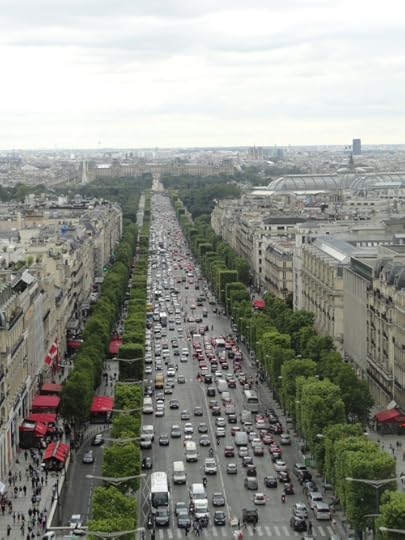
The Champs Élysées as seen from the top of the Arc de Triomphe
On our first afternoon, we walked to the Eiffel Tower (but didn’t climb it), then took a touristy boat ride over to Notre Dame and Ile de la Cité. The next day we climbed to the top of the Arc de Triomphe, then made our way to Montmartre and Sacré-Coeur. We found the Moulin Rouge, spent a few hours inside the Impressionists’ Museum, the Musée d’Orsay, then met a friend for a drink on the Champs Elysées. We took a whole day away from Paris to tour Versailles (at my husband’s wish, not mine, though I was willing).
Notre Dame Cathèdrale
Sacré-Coeur
Our last day in Paris was a rainy one, and we spent the morning at the Louvre. Then we wandered through the streets of the Marais district, had lunch and went to the Musée Carnavalet (Musée Picasso was closed). Afterward, we found our way back to Rue de Rivoli and located the famous Angelina Tea Room, known for its hot chocolate and delicious Mont Blanc dessert. But there was a queue, and since we were tired, we decided to pass, call it a day and go have a drink before dinner.
I had a long list of places to see and things to do in Paris that we missed, including the Musée Rodin, Saint-Germain-des-Près and the Jardin du Luxembourg. Though we had dinner one night at a wonderful restaurant in Montparnasse, we didn’t have time to explore the area. Due to lack of planning, we never dined at a 1-, 2- or 3-étoile restaurant — something we would have enjoyed very much, despite the price.
Next time, we’ll plan to stay in Paris much longer, make our dinner reservations ahead, and avoid many of les lieux touristiques.
I’m already happy just anticipating it.
*For more about those unexpected moments that are more fun than those we plan, see the post Américaine in Paris.



